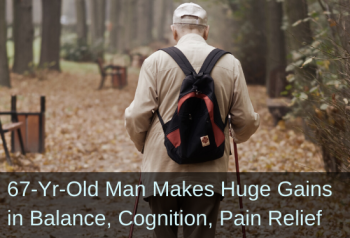Rhythmic Movements and Innate Reflex Integration Make a Big Difference for Senior Man
Submitted by Terrin Henderson, Occupational Therapist

|
Before
|
After
|
|
Back, neck, and hip stiffness
|
Less tension, strain and pain with the improved range of motion
|
|
Unable to stand on either leg for over 30 seconds
|
Able to stand with better control on the right leg for 48 seconds and on the left leg for 1:35 minutes
|
|
Frequently feels sleepy and often feels resistant to doing lessons (an online language class)
|
Better able to maintain focus
|
67-year-old man. Presenting challenges:
- Balance difficulties
- Significant flexibility challenges at hips, tightness in hamstrings
- Flexibility challenges in right knee, post knee-replacement surgery
- Attention and focus challenges for online language studies, crossword puzzles, Sudoku and other newspaper word games
- Probable ADHD (never formally diagnosed)
Client was taught the 5-step balance [From the Brain and Sensory Foundations course] and has been using it prior to online language classes. He reported that he frequently feels sleepy (like he needs to nap) and is often resistant to doing the lessons. On the first day of using the balance he reported that during the first lesson of the day, which took 10 minutes, things flowed well, he was able to maintain his focus and he had a perfect score (15/15). On the second lesson he felt tired again and missed 2 of the 15 questions. The 5-step balance was next done after simulating doing taxes. We ended the balance with some tapping: The Three Thumps and some other EFT points. The client stated that he felt great -- calm and happy. He stated that he felt ready to tackle the tax preparation.
During another session we went through a Brain Tune-up prior to the client working on a Sudoku that had been giving him trouble and he’d felt “stuck”. The tune-up didn’t do the trick; he was still feeling very sleepy and didn’t seem to be able to concentrate. At this point we used play to increase his focus and energize him. I gave him some energetic back slaps/rubs and he felt like this charged his battery/jump-started him and he started solving the puzzle well.
We also used the Moro Stimulation and integration isometrics [From the Brain and Sensory Foundations course] on multiple occasions due to this reflex’s association with balance issues and distractibility. Client had great difficulty maintaining legs in flexed position for entire time due to tightness in lower back and hips. RM#1 done passively and actively and client found this to be very calming and nurturing. I led the client through RM’s 1-4 actively. He needed coaching but was able to keep a rhythm going on all 4 movements. Practiced “butterfly” movements and just breathing and resting in the knees apart position (external hip rotation). This proved to be very challenging for the client. TLR isometrics done followed by ATNR isometrics.
Another activity we used, which the client felt was very useful for the back, neck and hip stiffness was the Core Activation [From the Brain and Sensory Foundations course]. His back felt tight and stiff prior to the exercise and he stated that he felt quite a bit better after just 2 minutes of the activation activity.
During several other sessions we used the rooting reflex stimulation/integration [From the Brain and Sensory Foundations , Second Level course]. Client reported significant relief after these; his neck muscles felt more relaxed with less strain and tension during movements afterwards.
We addressed his balance challenges during many sessions. During one early check he was unable to stand on either leg for over 30 seconds and he did quite a bit of wiggling and pinning of one leg against the other. One week later we rechecked and found that he was able to stand with better control on the right leg for 48 seconds and on the left leg for 1:35 minutes.
To address ongoing neck and upper back stiffness we used the TLR stim and isometrics followed by ATNR stim and isometrics. Lastly, we did STNR stim and isometrics.
In all of these reflexes the head position acts on the body and people can compensate for the effects by holding tension in the neck and core. We again included some rooting reflex stim and facial stroking. Client’s active ROM improved markedly with head turning to the left especially. He noted less tension, strain and pain with the improved range of motion.
[Edited, emphasis added]


